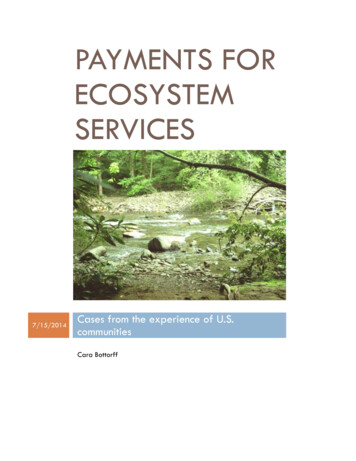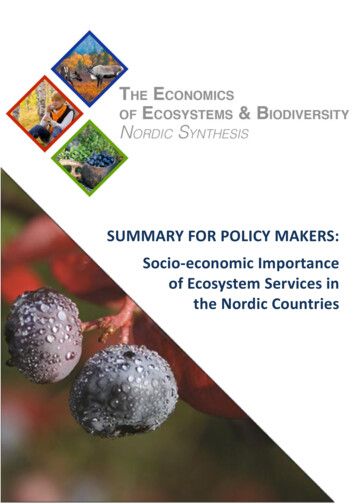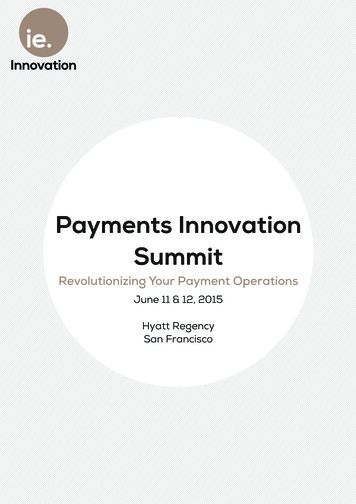
Transcription
PAYMENTS FORECOSYSTEMSERVICES7/15/2014Cases from the experience of U.S.communitiesCara Bottorff
Payments for Ecosystem ServicesFOREWORDPayments for Ecosystem Service, or PES programs are defined as “formal and informalcontracts in which landowners are remunerated for managing their land to produce one ormore ecosystem service, [and that involve] actual payments between at least one willing buyerand one willing seller to produce or enhance a well-defined ecosystem service or bundle ofservices (Mercer, Cooley, & Hamilton, 2011, p. 1).” But what do PES programs look like inpractice? How formal or informal does the payment mechanism need to be? And whatecosystem services (or ecosystem processes and benefits) are most amenable to these marketbased or market-like approaches to environmental problems?To help answer these questions for the benefit of landowners, community groups, localgovernments and businesses curious about whether such systems could become part of astrategy for addressing climate adaptation needs or other environmental concerns, Key-LogEconomics has commissioned this review of representative examples of PES programs fromaround the United States. Our intention is to inspire ideas for how to connect the resourcesneeds of those who can make improvements in the protection, restoration and enhancement ofecosystem processes to the resource capacity of individuals, businesses, governments, andcommunities who enjoy the benefits that spring from those processes.Independent researcher, Cara Bottorff, has done an excellent job sifting through dozens ofpotential case studies and describing those that best illustrate the breadth of creative PESapproaches underway today. Naturally, any set of cases will leave much good workunheralded, and I would encourage readers to do their own searching for further reading(start with the Bibliography at the end of this report) to get even more ideas as well as somesolid how-to advice from researchers and practitioners who have been at the forefront ofcreating PES programs.Spencer Phillips, PhD, PrincipalKey-Log Economics, LLCPage 1
Payments for Ecosystem ServicesPAYMENTS FOR ECOSYSTEM SERVICES:CASES FROM THE EXPERIENCE OF U.S. COMMUNITIESCara BottorffJuly 15, 2014For Key-Log Economics, Charlottesville, Virginiakeylogeconomics.comPage 2
Payments for Ecosystem ServicesContentsFOREWORD. 1OVERVIEW OF CASES AND KEY LESSONS. 4Definitions. 4CASE 1: COORDINATED SALMON RESTORATION ON PRIVATE LANDS . 9Location: Methow River Valley, North Central Washington . 9CASE 2: NEW YORK CITY’S WATERSHED . 11Location: Catskill-Delaware Watershed . 11CASE 3: PRICKLY PEAR CREEK . 13Location: Montana, between East Helena and Lake Helena . 13CASE 4: DISPERSED WATER MANAGEMENT PROGRAM NOTHERN EVERGLADES. 15Location: Lake Okeechobee Area, Florida . 15CASE 5: DENVER FORESTS TO FAUCETS PARTNERSHIP . 17Location: Denver City, surrounding Denver County, and Middle South Platte-Cherry CreekWatershed . 17CASE 6: KANSAS WALK IN HUNTING ACCESS . 19Location: Kansas . 19CASE 7: GO ZERO . 21Location: Upper Ouachita National Wildlife Refuge . 21CASE 8: THE BAY BANK: THE CHESAPEAKE’S CONSERVATION MARKETPLACE . 23Location: Chesapeake Bay and Surrounding Area . 23CASE 9: NAPA FLOOD PLAIN RESTORATION . 25Location: Napa California . 25CASE 10: CONSERVATION RESERVE PROGRAM . 27Location: Farmland Across the United States . 27CASE 11: COLORADO HABITAT EXCHANGE . 29Location: Colorado . 29CASE 12: LENTS FLOOD PLAIN RESTORATION . 30Location: Portland, Oregon . 30CASE 13: SUSTAINING THE WATERSHED . 32Location: Santa Fe, New Mexico . 32PHOTO AND IMAGE CREDITS. 34WORKS CITED . 34Page 3
Payments for Ecosystem ServicesOVERVIEW OF CASES AND KEY LESSONSThe cases included below include a wide variety of types of Payment for Ecosystem Services,or “PES” programs. The cases vary by payment type, ecosystem services involved, and theend goal of the purchase. The locales span the United States, from New York to California,and from Georgia to Washington, so they represent a sample of what the United States hastried and offer lessons applicable to future PES programs.Each case offers unique insights into specific situations, but there are some aspects that arelargely seen across the board. PES schemes seem to all benefit greatly from a strong andbroad coalition of groups supporting them from the early planning stages throughimplementation. PES schemes are still relatively new and people can be resistant to new anddifferent things. Having these coalitions helps to gain trust and respect from communities andpartners, which increases the chances of program success. Allowing adequate time is anothertheme that seems to greatly enhance the chance of success. Creating these partnerships andnavigating the new terrain of PES schemes takes time and patience. Many of these cases wereonly successful because the parties involved were willing to put in up to years of time in orderto make it happen. As the cases demonstrate, the benefits of these PES schemes make the timeand work put in to make them happen more than completely worth it.DefinitionsBefore diving into the cases themselves, we begin with some key definitions. First, as definedby Mercer, Cooley and Hamilton, PES programs are “formal and informal contracts in whichlandowners are remunerated for managing their land to produce one or more ecosystemservice, [that involve] of actual payments between at least one willing buyer and one willingseller to produce or enhance a well-defined ecosystem service or bundle of services (2011, p.1).” In considering and selecting cases to include here, I have adopted a broad view of whatconstitutes such key features as remuneration and “actual payment.” So, for example,payment might come from a third party, such as a government program, or in the form of inkind goods and services. On the suppliers’ side the service can be in the form of measuredbenefits or the maintenance of green infrastructure from which ecosystem services flow.Next, we need to understand what an “ecosystem service” is, and more specifically, wherethey come from, and what it is that makes an ecosystem service of value to people. By these,we can understand both the basis for a payment and the purpose to which a payment wouldbe put. Ecosystem services are known broadly “benefits people obtain from ecosystems” (Reidet al., 2005; USDA Forest Service, 2012), but Gary Johnson of the University of Vermont,adds some specificity that will make it easier to understand what PES programs accomplish. Inhis words, ecosystem services are “the effects on human well-being of the flow of benefitsfrom an ecosystem endpoint to a human endpoint at a given extent of space and time(Johnson, 2010).” By this definition, the time and location at which a benefit is delivered isclearly important – a very valuable consideration in PES programs. The definition also makesit clear that ecosystem services are about effects on human well-being, not “nature for nature’ssake” or intrinsic values. This, too, is important to keep in mind in considering where PESprograms could be helpful and how to design them: one must have a clear idea of whichpeople would benefit and who would pay for the delivery of the benefit.Page 4
Payments for Ecosystem ServicesOne final take on “ecosystem services” is provided by Andrew Balmfod and his co-authors,who distinguish between the “ecosystem processes” that result in biophysical goods andservices, such as a quantity of water or the appearance of a landscape on the one hand, and“ecosystem benefits,” such as drinking water or nature-based recreational experiences on theother (Balmford et al., 2010, 2013). These align nicely with the “ecosystem endpoints” and“human endpoints” of Johnson’s definition. Moreover, for PES designers, Balmford clarifiesthat there is something that delivers value to people by satisfying human needs or wants, andthere are biophysical processes that deliver that something. Typically, the sellers in a PESarrangement are taking actions to protect, restore or maintain those processes, whereas thebuyers are, naturally, enjoying one or more benefits from those landscape managementactions.Taking cues from these definitions, each PES example below is characterized by the ecosystemprocess or processes involved on the supply side of the transaction, as well as by theecosystem benefits delivered to the demand side. Table 1 lists all the possible processes andbenefits, along with short definitions and icons that will serve as flags for specific processesand benefits involved in each example.TABLE 1: ECOSYSTEM PROCESSES AND BENEFITSProcess or BenefitaDefinitionaIconbEcosystem ProcessesPrimary BiomassProductionProduction of plant biomass, or the accumulation ofbiomass by organisms that use inorganic sources ofenergy (i.e., plants) (Mr. G's Environmental Systems)SecondaryBiomassProductionAccumulation of biomass by animals and otherorganisms from organic energy sourcesPollinationContribution of insects, birds, bats and otherorganisms to pollen transport resulting in theproduction of fruit and seeds. May also includeseed and fruit dispersal.Biological controlInter- and intra-specific interactions resulting inreduced abundance of species that are pests,vectors of disease, or invasive in a particularecosystem.Other ecologicalinteractionsOther inter- and intra-specific interactions, forexample competition and predation, wildland fire,etc.Formation ofspecies habitatFormation of the physical properties of the habitatsnecessary for the survival of species (canopystructure in forests, coral reefs).Page 5
Payments for Ecosystem ServicesProcess or BenefitaDefinitionaSpeciesdiversificationThe production of genetic diversity ACROSSspecies.GeneticdiversificationThe production of genetic diversity WITHIN species.Waste assimilationRemoval of contaminants from the soil in anecosystem, including through biological processessuch as decomposition or assimilation.Soil formationProcess by which soil is created, including changesin soil depth, structure and fertility.Erosion regulationControl of the processes leading to erosion, forexample, by controlling the effects of water flow,wind or gravity.Formation ofphysical barriersFormation of structures that attenuate the energy of(or block) water or wind flow (mangroves, dunes,forests).Formation ofpleasant sceneryFormation of landscapes that are attractive topeople.Air qualityregulationRemoval of contaminants from air flowing throughan ecosystem, including through physical processes(filtration) or biological processes (decomposition orassimilation).Regional/localclimate regulationModulation of regional/local climate (temperature,humidity, wind events).Water regulation(timing)Regulation of the timing of water flow through anecosystem (attenuation of floods/droughts).Water purification(quality)Removal of contaminants from water flowingthrough an ecosystem, including through physicalprocesses (filtration) or biological processes(decomposition or assimilation).Page 6Iconb
Payments for Ecosystem ServicesProcess or BenefitaDefinitionaWater provisioning(quantity)Changes in the quantity of water flowing throughan ecosystem.Global climateregulationGlobal climate regulation: Modulation of globalclimate and ocean acidity through changes in theconcentration of greenhouse gases in theatmosphere.IconbEcosystem BenefitsFood: Freshwater (fordirectconsumption;excludes irrigationwater, covered incrops) Raw materials Energy Crops, including orchard fruit and nuts,mushrooms, cultivated algae, etc.Livestock, including poultryMarine fisheries, both wild/capture fisheriesand aquacultureInland/Freshwater fisheries, both wild/capturefisheries and aquacultureWild animal products, including bush meat,invertebrates, etc.Wild plants for food, including mushrooms,ramps, etc.Drinking water (at the tap, in a bottle, orstraight from the spring)Industrial process water (e.g., papermaking, brewing and bottling, foodprocessing, etc.)Crops, such as cotton and flaxLivestock, such as wool and other fiberWild plants or animals for fiber, includingrattan, hidesTimber both from natural forests and fromplantationsBiofuels from domestic plantsCharcoal/firewood from wild plantsDung from livestockWorking animals (oxen, llama)Hydroelectric energyPage 7
Payments for Ecosystem ServicesProcess or BenefitaProperty:Definitiona Physical health(excludingnutrition, coveredunder Food) Psychologicalwellbeing Knowledge Passive UseBenefits Preventing loss of property value orconditionTransportation and other infrastructurecondition (roads, hospitals, factories)From One-time use benefits (synthesis ofmedicines copied from/inspired by naturalproducts)Wild medicinal plantsNature-related outdoor activities thatmaintaining health and fitnessAvoiding injury and illness from naturalhazards, biological agents, pollution, etc.Crops and Livestock (gardening andinteractions with pets, maintenance ofrural/farming lifestyle)Nature-related outdoor activities (hiking,diving, viewing attractive scenery)From Marine and Inland fisheries and Wildanimal products (i.e. watching fish, birds,animals)Nature-related outdoor activitiesOne-time use benefits (new scientificdiscoveries, artistic inspiration)Through education about the natural world.Option Value, the value of preserving acomponent of nature for possibly future useby oneselfBequest Value, the value of preservingsomething for future use by others (heirs orunspecified members of a futuregeneration)Existence Value, the value of simplyknowing that something exists and enduresin a healthy state absent any expectationof future direct use.a. Sources: Phillips (2013), Balmford (2010, 2013).b. Photo and image credits for icons are listed below on page 34.Page 8Iconb
Payments for Ecosystem ServicesCASE 1: COORDINATED SALMON RESTORATION ON PRIVATELANDSLocation: Methow River Valley, Nor th Central WashingtonEcosystem Processes: Water Regulation (quantity, quality and timing); Secondary biomassproduction; Formation of species habitatEcosystem Benefits: Food; Property; Passive Use BenefitSalmon Recovery requires the restoration of spawning habitat to improve egg-to-smoltsurvival. In the Methow River Valley, a partnership between a federal agency, the FederalBureau of Reclamation (BOR), and a local nonprofit, Methow Salmon Recovery Foundation(MSRF) has been successful in using PES to accomplish this. BOR manages six hundred damsand reservoirs across the U.S. delivering water to municipal and agricultural areas. Recently,BOR has had to extend its reach in order to mitigate the effects of its infrastructure and tohelp implement the Endangered Species Act (ESA). The BOR is hampered in its ability to workon private lands due to lack of legal authority and lack of landowner trust. This is where TheMethow Salmon Recovery Foundation comes in. MSRF was created in order to help farmerscomply with ESA in the way that benefits them the most. This partnership has been extremelybeneficial because the MSRF has the trust of local landowners that enables the implementationof BOR’s goals. Together these institutions comprise the buyer of the ecosystem service ofsalmon habitat.BOR and MSRF work together to identify, plan, design, and permit projects to helpsalmon on private lands. For instance they will install irrigation diversion dams with structuresthat allow fish passage or restore salmon habitat. Once problems have been assessed andpossible fixes have been prioritized, MSRF reaches out to individual local landowners andholds face-to-face meetings with them. This step identifies interested landowners that will bepartners, ecosystem service providers, in the PES scheme. MSRF and BOR work together toseek funding from institutions like Bonneville Power Administration or the Upper ColumbiaSalmon Recovery Board that have interests in maintaining salmon habitat.This system utilizes a combination of funds from federal appropriations and legalsettlements for dam mitigation in order to encourage local landowners to improve waterwaysfor salmon. This is an example of a public payment scheme for private landowners, in thatBOR and other government groups fund many of the projects facilitated by a private group,MSRF, which attains the trust of landowners. Landowners also get the benefits of increasedproperty values and increased irrigation efficiencies, which result in cost savings that are keyto attracting participants. Fifty out of eighty landowners on a stretch of river between thetowns of Winthrop and Twisp have met with MSRF, demonstrating the success of the outreachfor partners. As of summer 2011, twenty out of this group are moving forward with projects.Since the 1990s salmon runs have improved likely due to the new salmon territory that theseprojects have opened up (“Coordinated Salmon Habitat Restoration on Private Lands,” 2013).In 2010, it was considered a good year when 5,500 naturally spawning salmon andsteelhead appeared in the Methow River (Torvik, 2014).The success of this PES scheme can belargely attributed to the trust between MSRF and local landowners as well as to the personalbenefits that local landowners receive.Page 9
Payments for Ecosystem ServicesContacts:Chris Johnson, MSRF President: (509)-429-1232, chrisj@methowsalmon.orgProgram Website: http://www.methowsalmon.org/.Page 10
Payments for Ecosystem ServicesCASE 2: NEW YORK CITY’S WATERSHEDLocation: Ca tskill-Delaware WatershedEcosystem Processes: Water Regulation (quality); Formation of Species Habitat; WasteAssimilation; Formation of Pleasant SceneryEcosystem Benefits: Food; Freshwater; Physical Health; Psychological Wellbeing; PropertyNew York City (NYC) has taken a unique approach to keeping its drinking waterclean. The U.S. Safe Drinking Water Act says that drinking water providers must filter theirwater unless they can prove that their natural water system’s process and natural conditionsprovide safe water and that they are proactively protecting their watersheds in such a waythat water quality standards will continue to be met (US EPA, Office of Water, 1996). MostU.S. cities have chosen to filter their water, but NYC is the largest city in the U.S. to choosewatershed protection instead of a filtration plant. After years of negotiation NYC signed amemorandum of agreement (MOA) in 1997 that set up the watershed protection plan. This setNYC up as the buyer of the ecosystem service of water quality from many sellers, 70 townsand villages in the Catskill-Delaware watershed, which provides 90% of NYC’s drinkingwater. The MOA committed NYC to investing 1.5 billion over 10 years to restore and protectthe watershed and to improve the local economies and quality of life of watershed residents.In the first 5 years NYC solicited sales for 258,719 acres and signed 477 purchase contractsfor 34,446 acres for a total purchase price of about 94 million, which about doubled thearea of protected buffer land surrounding the 8 reservoirs in the Catskill-Delaware watershed(Postel & Thompson, 2005). Funding is public, taken from additional taxes on residents’ waterbills and from bonds issued by the city. Compared to the estimated cost of a filtration plant, 6 billion in capital costs, then 300 million in annual operation and maintenance costs, thiswas an extremely good deal, and residents’ water costs are still lower than they would be if afiltration plant were built.There can often be a disconnect between those who bear the costs of watershedprotection and those who reap the benefits, so this represents a perfect situation for a PESconnection to be made. The beneficiaries are widespread including water suppliers,hydroelectric power producers, water users downstream, and residents of NYC who benefitfrom reduced water costs. Residents in the watershed also benefit in many ways. They receivethe benefits from improved fishing and water quality. 6,919 ac of NYC’s newly acquired landhave been opened for public recreational uses like fishing, hunting, and hiking, which improvethe quality of life for residents. NYC has also established a 60 million dollar trust fund thatprovides loans and grants for environmentally sustainable economic development projects inthe watershed communities, which promotes economic development for these areas whilemaking sure it is consistent with water quality protection.This program has been hugely successful. After the first five years there was enoughproof of watershed protection and improvement for the EPA to waive the filtrationrequirement for NYC. Most recently by submitting its “Long Term Watershed Protection Plan”in 2007, NYC received a 10-year Filtration Avoidance Determination (FAD) from the EPA thatruns from 2007-2017 (“Regulatory Background,” n.d.). This may become more difficult as thePage 11
Payments for Ecosystem Servicespopulation and economy grows in the watershed region and federal water quality standardsbecome stricter. However, NYC has set itself up for success by forming broad partnershipswith state and federal agencies, environmental groups, and partners in the watershed that canbetter reach local populations to implement program goals.Contact: Barton H. Thompson Jr.: buzzt@stanford.edu, 650-723-2518NYC Department of Environmental Protection: 212-639-9675Program Website: http://www.nyc.gov/html/dep/html/watershed protection/index.shtmlPage 12
Payments for Ecosystem ServicesCASE 3: PRICKLY PEAR CREEKLocation: Montana, between East Helena and Lake HelenaEcosystem Processes: Water Regulation (quantity and timing); Formation of Species HabitatEcosystem Benefits: Freshwater; PropertyTens of thousands of miles of streams in the U.S. are now dewatered. In Montanaalone there are 4,000 miles of dewatered creeks. This trend is a serious one that threatensmany ecosystem functions. The case of Prickly Pear Creek shows a huge success that can becopied to help alleviate this problem elsewhere as well.Montana struggles to keep streams flowing because of a poorly crafted legal right,senior water rights. Senior water rights give the rights to water in streams to those who werethere first. However, if these people don’t use their water rights by diverting water from thestreams, they run the risk of losing their water rights along with the economic value that isattached to it. This has led to the overdrawing of streams until many streams like Prickly PearCreek run dry. In Prickly Pear Creek’s case it has run dry for over 100 years in the summer.Now, a PES solution has been tested that has returned water to the creek.Breweries in Montana, as well as other companies aroundthe U.S. and world care about their water footprint because ofconcerns about supply and efficiency and how it affects theirbrand image. Brewing is very water intensive: a single pint takesabout 5 pints of water to make, and if you count the water thatgoes into grain production, the water cost of a pint of beer jumpsto 100 pints (Harmon, 2010). Breweries in Montana who careabout their water footprint, and who know that their costumerscare about their water footprint are a group extremelyinterested in being buyers of water provisioning. Workingthrough local water trusts, breweries have been linked withFIGURE 1: PRICKLY PEAR CREEK BEFORE FLOWRESTORATIONprivate citizens who hold senior water rights and are sellers ofthis ecosystem service. The private senior water rights holdersclose the diversions they use to extract water from the stream.The amount of water that is left in the stream is measured anddivided into thousand gallon increments, which are given a serialnumber. Brewers can then buy this water as a certificate and thepayment goes to the private senior water rights holders. Thiscreates an incentive for private water rights holders to leavetheir water rights in the stream. It is extremely beneficial to thembecause they get to receive payment to keep their water rightsFIGURE 2: PRICKLY PEAR CREEK AFTER FLOWbut leave the water in the stream protected from other users. ItRESTORATIONalso pumps economic activity into rural economies. This benefitsbusinesses that care about their water footprint by giving them a clear way to manage it.Page 13
Payments for Ecosystem ServicesThis PES scheme using private funding has been highly successful, returning 4 billiongallons of water to degraded ecosystems. This has allowed Prickly Pear Creek to maintainconnectivity throughout irrigation season, something that has not been possible in many years,and supports about 2 river miles of additional usable habitat (“Prickly Pear Creek,” n.d.). Thebuyers from Prickly Pear Creek have been expanded to include hotels and tea companies inOregon as well as water guzzling hi-tech companies in the southwest.Contact:Clark Fork Coalition: (406)-542-0539, info@clarkfork.orgBonneville Environmental Foundation: (503)-248-1905, info@b-e-f.orgProgram rg/project-portfolio/prickly-pear-creek/Page 14
Payments for Ecosystem ServicesCASE 4: DISPERSED WATER MANAGEMENT PROGRAM NOTHERNEVERGLADESLocation: Lake Okeechobee Area, FloridaEcosystem Processes: Primary Biomass Production; Formation of Species Habitat; Formationof Physical Barriers; Water Regulation (quantity, quality and timing); Waste AssimilationEcosystem Benefits: PropertyLake Okeechobee has experienced excess water levels, which has had detrimentaleffects such as flooding and with it the loss of crop production, damage to houses and othercosts. Beginning in 2005 the Dispersed Water Management Program created collaborationbetween agencies, environmental organizations, ranchers, and researchers, to attack thisproblem using a PES scheme.This program uses public funding from agencies such as the Florida Department ofEnvironmental Protection, South Florida Water Management District, and Florida Departmentof Agriculture and Consumer Services. These agencies make up the buyers who createpartnerships with local ranchers and landowners, the sellers, in order to help store excesswater on their private property. Storing water upstream will help prevent overfilling LakeOkeechobee and potential discharges into surrounding estuaries such as St. Lucie andCaloosahatchee. In October 2011, 8 pilot projects were run to see how well a PES schememight work in this situation. These pilot projects were extremely successful with one removing8.4 metric tons of phosphorus in one year (Smith, 2011). This success has fueled the initiation ofmore projects. In November 2011, 8 new contracts with ranchers were added to the project.The District will invest 7 million over 10 years for this round of contracts. In addition 46million has been designated for the next five years to help reach program goals. These newcontracts provide many benefits. They will provide 4,800 acre-feet of regional storage andadditional nutrient benefits, such as preventing phosphorus from reaching Lake Okeechobee.This also creates additional security from flooding for surrounding communities. The ranchesstoring the water will support local plants and wildlife by rehydrating the land. Additionallythis program has reduced costs from traditional government land acquisition programs thatwould burden taxpayers with new debt needed to buy the land. It also keeps the ranch landson local tax rolls. Together these factors help sustain the lo
needs of those who can make improvements in the protection, restoration and enhancement of ecosystem processes to the resource capacity of individuals, businesses, governments, and . from an ecosystem endpoint to a human endpoint at a given extent of space and time (Johnson, 2010)." By this definition, the time and location at which a .










